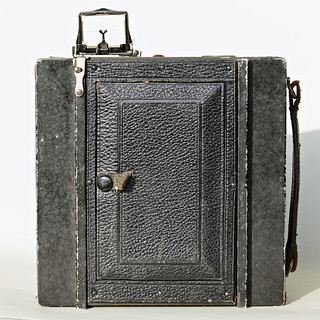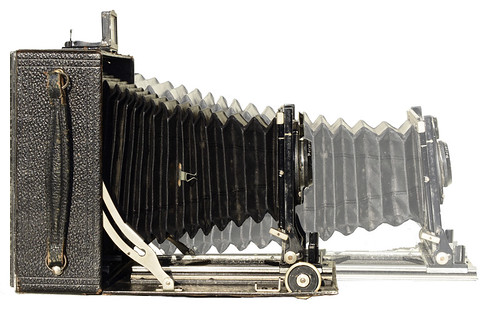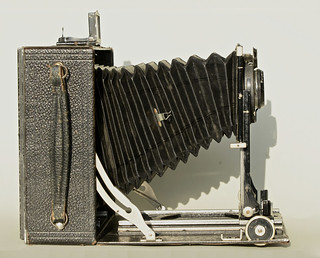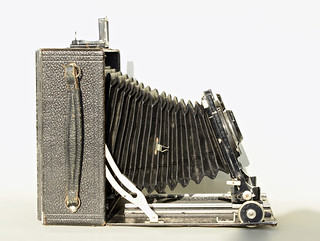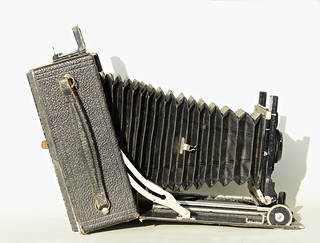Difference between revisions of "Unoplast"
(link fix) |
Hanskerensky (talk | contribs) (Added Category year of introduction (according to Kadlubeks Catalog in 1912)) |
||
| (8 intermediate revisions by 3 users not shown) | |||
| Line 7: | Line 7: | ||
|image_by= Dirk HR Spennemann | |image_by= Dirk HR Spennemann | ||
|image_rights= with permission | |image_rights= with permission | ||
| − | |||
}} | }} | ||
| − | + | The [[Staeble | Dr. Staeble]] '''Unoplast''' camera is a plate camera with [[triple extension]] bellows manufactured by Dr. Franz [[Staeble]] (München, Germany). It was offered in the following formats: | |
| − | The [[Staeble | Dr. Staeble]] Unoplast camera is a plate camera with [[ | ||
6 x 9; 9 x 12; 10 x 15; 13 x 18; and 18 x 24cm.<ref name="Catalog1914"> Photographische Objektive. Ausgabe 1914. Optisches Werk Dr. Staeble & Co G.m.b.H. München, Daiser Str. 15. München: Staeble, 1914. [exact imprint date15 May 1914]. p. 39.</ref> At least three versions are documented. | 6 x 9; 9 x 12; 10 x 15; 13 x 18; and 18 x 24cm.<ref name="Catalog1914"> Photographische Objektive. Ausgabe 1914. Optisches Werk Dr. Staeble & Co G.m.b.H. München, Daiser Str. 15. München: Staeble, 1914. [exact imprint date15 May 1914]. p. 39.</ref> At least three versions are documented. | ||
====pre-World War I version==== | ====pre-World War I version==== | ||
The pre World War I version seems to have been made of solid wood, with a centrally located [[Viewfinder#Newton finder|Newton finder]]. The front board also has a fold-up wire frame sportsfinder.<ref>This version is reproduced in the 1913 and 1914 advertisements. The same cliché is used until 1919, for example in the [[Polyplast]] advertisement.</ref> | The pre World War I version seems to have been made of solid wood, with a centrally located [[Viewfinder#Newton finder|Newton finder]]. The front board also has a fold-up wire frame sportsfinder.<ref>This version is reproduced in the 1913 and 1914 advertisements. The same cliché is used until 1919, for example in the [[Polyplast]] advertisement.</ref> | ||
| − | Another wooden 10x15 version exists with a [[ | + | Another wooden 10x15 version exists with a [[Brilliant finder]] centrally mounted on the front board.<ref name="Norway">[https://web.archive.org/web/20160310011149/http://www.fotomuseetiosby.nu/e-sida.html Norway Photomuseum] (archived)</ref> |
====post-World War I version==== | ====post-World War I version==== | ||
| − | The well-built, very sturdy full-metal camera measures 192 X 186 X 90 mm (closed), 244 mm (opened). The maximum extended length is 363mm. Given the full metal body, the cameras weighs over 2kg.—The removable front board is set in a front standard with geared vertical movement (rise) but no sideways movement. The standard allows for tilt to 20º from the vertical, but only backwards. The lack of forward tilt of the standard is compensated by the folding bed which allows for two angles, the standard 90º, as well as 110º.—The camera body has a fold-up [[Viewfinder#Newton finder|Newton finder]] placed at the top left and a water-filled spirit level mounted on the top right. There are two tripod sockets, a protruding reinforced socket on the folding bed and sunk one on the left hand side. A leather carry strap is on the right. While the camera has an almost square body with square bellows, but the camera back is a standard 10 x 15, aligned vertically. The actual negative size appears to be 95 x 145mm.<ref name="DHRS">[http://www.flickr.com/photos/heritagefutures/8269021553/ Photographica Collection Dirk HR Spennemann] made in 1927</ref> | + | The well-built, very sturdy full-metal camera measures 192 X 186 X 90 mm (closed), 244 mm (opened). The maximum extended length is 363mm. Given the full metal body, the cameras weighs over 2kg.—The removable front board is set in a front standard with geared vertical movement (rise) but no sideways movement. The standard allows for tilt to 20º from the vertical, but only backwards. The lack of forward tilt of the standard is compensated by the folding bed which allows for two angles, the standard 90º, as well as 110º.—The camera body has a fold-up [[Viewfinder#Newton finder|Newton finder]] placed at the top left and a water-filled spirit level mounted on the top right. There are two tripod sockets, a protruding reinforced socket on the folding bed and sunk one on the left hand side. A leather carry strap is on the right. While the camera has an almost square body with square bellows, but the camera back is a standard 10 x 15, mounted on a turnable plate so that it can be aligned vertically or horizontally. The actual negative size appears to be 95 x 145mm.<ref name="DHRS">[http://www.flickr.com/photos/heritagefutures/8269021553/ Photographica Collection Dirk HR Spennemann] made in 1927</ref> |
In its standard version, the Unoplast camera came fitted with a Dr. Staeble Doppel-Anastigmat. Most units were delivered with a special quarter-turn bayonet that allowed for rapid exchange of the front cell while the back cell remained in place. Additional front cells, to achieve a variety of focal lengths, was sold as the [[Polyplast]] expansion set. | In its standard version, the Unoplast camera came fitted with a Dr. Staeble Doppel-Anastigmat. Most units were delivered with a special quarter-turn bayonet that allowed for rapid exchange of the front cell while the back cell remained in place. Additional front cells, to achieve a variety of focal lengths, was sold as the [[Polyplast]] expansion set. | ||
| Line 46: | Line 44: | ||
|image= http://farm9.staticflickr.com/8485/8269018461_c9044dc3f6.jpg | |image= http://farm9.staticflickr.com/8485/8269018461_c9044dc3f6.jpg | ||
|image_align= center | |image_align= center | ||
| + | }} | ||
| + | |- | ||
| + | |colspan=3 align="center"| | ||
| + | {{Flickr_image_caption | ||
| + | |image_text= Dr. Staeble Unoplast with Polyplast f/6.3 16.5cm (1927) | ||
| + | |image_by= Dirk HR Spennemann | ||
| + | |image_rights= with permission | ||
| + | }} | ||
| + | |} | ||
| + | {|class=plainlinks align=center | ||
| + | || | ||
| + | {{Flickr_image | ||
| + | |image_source= http://www.flickr.com/photos/heritagefutures/8270083720/in/pool-camerawiki | ||
| + | |image= http://farm9.staticflickr.com/8347/8270083720_e8b502e595_n.jpg | ||
| + | |image_align= center | ||
| + | |image_text= rise of the front board | ||
| + | }} | ||
| + | || | ||
| + | {{Flickr_image | ||
| + | |image_source= http://www.flickr.com/photos/heritagefutures/8269018007/in/pool-camerawiki | ||
| + | |image= http://farm9.staticflickr.com/8499/8269018007_53171ed581_n.jpg | ||
| + | |image_align= center | ||
| + | |image_text= tilt of the front board (max. 20º) | ||
}} | }} | ||
|| | || | ||
| Line 52: | Line 73: | ||
|image= http://farm9.staticflickr.com/8356/8269017187_1b4139592b_n.jpg | |image= http://farm9.staticflickr.com/8356/8269017187_1b4139592b_n.jpg | ||
|image_align= center | |image_align= center | ||
| − | }} | + | |image_text= additional tilt of folding bed (20º) |
| + | }} | ||
|- | |- | ||
| − | |colspan= | + | |colspan=3 align="center"| |
{{Flickr_image_caption | {{Flickr_image_caption | ||
| − | |image_text= | + | |image_text= Bellows movement of the Staeble Unoplast (1927) |
|image_by= Dirk HR Spennemann | |image_by= Dirk HR Spennemann | ||
|image_rights= with permission | |image_rights= with permission | ||
}} | }} | ||
|} | |} | ||
| − | |||
==Advertisements== | ==Advertisements== | ||
| Line 76: | Line 97: | ||
<references /> | <references /> | ||
| − | [[Category:German | + | [[Category:German 10x15 folding]] |
| − | [[Category: | + | [[Category:1911-1914]] |
| − | [[Category: | + | [[Category:U]] |
Latest revision as of 05:12, 28 January 2024
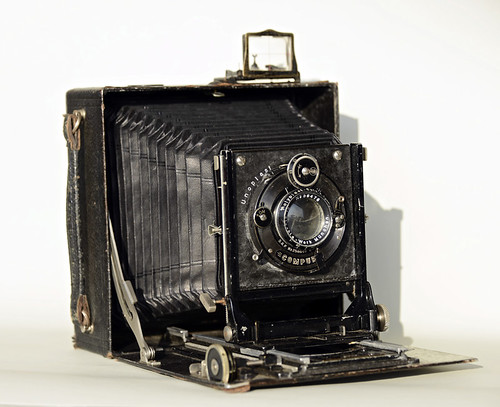
|
| Dr. Staeble Unoplast with Polyplast f/6.3 16.5cm (1927) image by Dirk HR Spennemann (Image rights) |
The Dr. Staeble Unoplast camera is a plate camera with triple extension bellows manufactured by Dr. Franz Staeble (München, Germany). It was offered in the following formats: 6 x 9; 9 x 12; 10 x 15; 13 x 18; and 18 x 24cm.[1] At least three versions are documented.
pre-World War I version
The pre World War I version seems to have been made of solid wood, with a centrally located Newton finder. The front board also has a fold-up wire frame sportsfinder.[2]
Another wooden 10x15 version exists with a Brilliant finder centrally mounted on the front board.[3]
post-World War I version
The well-built, very sturdy full-metal camera measures 192 X 186 X 90 mm (closed), 244 mm (opened). The maximum extended length is 363mm. Given the full metal body, the cameras weighs over 2kg.—The removable front board is set in a front standard with geared vertical movement (rise) but no sideways movement. The standard allows for tilt to 20º from the vertical, but only backwards. The lack of forward tilt of the standard is compensated by the folding bed which allows for two angles, the standard 90º, as well as 110º.—The camera body has a fold-up Newton finder placed at the top left and a water-filled spirit level mounted on the top right. There are two tripod sockets, a protruding reinforced socket on the folding bed and sunk one on the left hand side. A leather carry strap is on the right. While the camera has an almost square body with square bellows, but the camera back is a standard 10 x 15, mounted on a turnable plate so that it can be aligned vertically or horizontally. The actual negative size appears to be 95 x 145mm.[4]
In its standard version, the Unoplast camera came fitted with a Dr. Staeble Doppel-Anastigmat. Most units were delivered with a special quarter-turn bayonet that allowed for rapid exchange of the front cell while the back cell remained in place. Additional front cells, to achieve a variety of focal lengths, was sold as the Polyplast expansion set.
Documented Examples
Unoplast 10x15 cm
- with Doppel-Anastigmat f/ 5.4 120 mm in Compound shutter (~1910s)[3]
- with Doppel-Anastigmat f/ 6.3 165 mm in Compur shutter (~1920s)[4]
|
|
| ||||||
|
Dr. Staeble Unoplast with Polyplast f/6.3 16.5cm (1927) | ||||||||
|
|
| ||||||
|
Bellows movement of the Staeble Unoplast (1927) | ||||||||
Advertisements
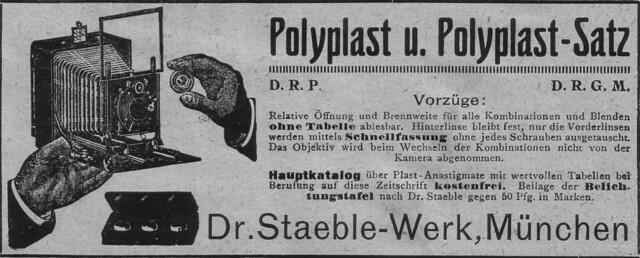
|
| 1919 advertisement for the Dr. Staeble Unoplast with the Polyplast lens kit scanned by Uwe Kulick (Image rights) |
Notes
- ↑ Photographische Objektive. Ausgabe 1914. Optisches Werk Dr. Staeble & Co G.m.b.H. München, Daiser Str. 15. München: Staeble, 1914. [exact imprint date15 May 1914]. p. 39.
- ↑ This version is reproduced in the 1913 and 1914 advertisements. The same cliché is used until 1919, for example in the Polyplast advertisement.
- ↑ 3.0 3.1 Norway Photomuseum (archived)
- ↑ 4.0 4.1 Photographica Collection Dirk HR Spennemann made in 1927

